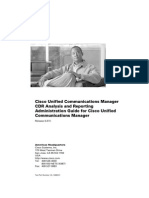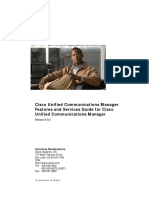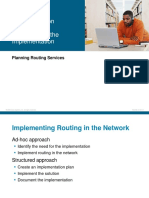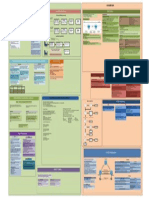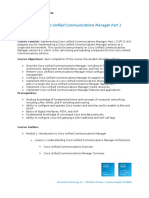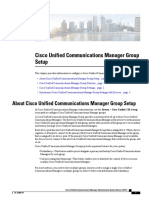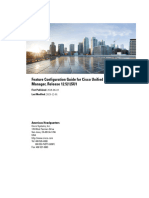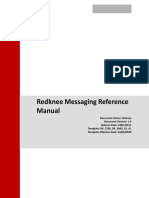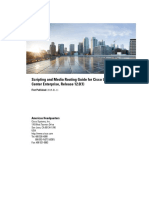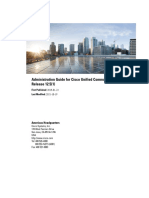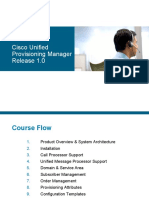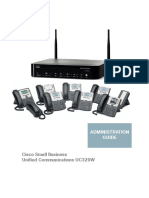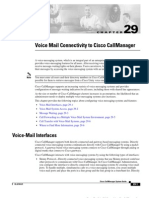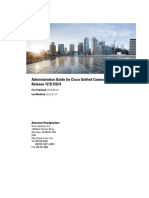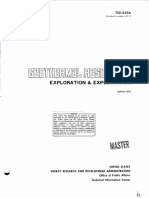Cisco Route Pattern Configuration Guide
Uploaded by
Pablin MilianCisco Route Pattern Configuration Guide
Uploaded by
Pablin MilianCH A P T E R 33
Route Pattern Configuration
Use the following topics to find, add, update, copy, or delete a route pattern:
• Route Pattern Configuration Settings, page 33-1
• Related Topics, page 33-11
Route Pattern Configuration Settings
In Cisco Unified Communications Manager Administration, use the Call Routing > Route/Hunt >
Route Pattern menu path to configure route patterns.
A route pattern comprises a string of digits (an address) and a set of associated digit manipulations that
route calls to a route list or a gateway. Route patterns provide flexibility in network design. They work
in conjunction with route filters and route lists to direct calls to specific devices and to include, exclude,
or modify specific digit patterns.
See “Understanding Route Plans” in Cisco Unified Communications Manager System Guide for more
detailed route pattern information.
Note See the “Local Route Groups” chapter in the Cisco Unified Communications Manager Features and
Services Guide for a discussion of route patterns and their use and configuration when the Local Route
Group feature is configured.
Tips About Configuring Route Patterns
Before you begin, ensure that the following items are configured in Cisco Unified Communications
Manager:
• Gateway
• Route list
• Partition (unless you are using <None>)
• Route filter (unless you are using <None>)
Timesaver Assigning 8XXX to a gateway routes all directory numbers 8000 to 8999 out the gateway. Similarly,
82XX routes directory numbers 8200 to 8299. See the “Special Characters and Settings” section in the
Cisco Unified Communications Manager System Guide for more information about wildcards.
Cisco Unified Communications Manager Administration Guide
OL-22751-01 33-1
Chapter 33 Route Pattern Configuration
Route Pattern Configuration Settings
Note If you change the gateway or route list, you must click Save prior to choosing the Edit link. Otherwise,
you get linked to the previous gateway or route list.
Note The (Edit) link next to the Gateway or Route List field takes you to the Gateway Configuration or Route
List Configuration window for reference, depending on whether the Gateway or Route List field contains
a gateway or a route list. The Gateway Configuration window displays devices that are associated with
the specified gateway. The Route List Configuration window displays the route groups that are
associated with the specified route list.
Using the GUI
For instructions on how to use the Cisco Unified Communications Manager Administration Graphical
User Interface (GUI) to find, delete, configure, or copy records, see the “Navigating the Cisco Unified
Communications Manager Administration Application” section on page 1-13 and its subsections, which
explain how to use the GUI and detail the functions of the buttons and icons.
Configuration Settings Table
Table 33-1 describes the available fields in the Route Pattern Configuration window. For related
procedures, see the “Related Topics” section on page 33-11.
Table 33-1 Route Pattern Configuration Settings
Field Description
Pattern Definition
Route Pattern Enter the route pattern, including numbers and wildcards (do not use spaces);
for example, for NANP, enter 9.@ for typical local access or 8XXX for a
typical private network numbering plan. Valid characters include the
uppercase characters A, B, C, and D and \+, which represents the international
escape character +.
Note Ensure that the directory route pattern, which uses the chosen
partition, route filter, and numbering plan combination, is unique.
Check the route pattern, translation pattern, directory number, call
park number, call pickup number, message waiting on/off, or meet me
number if you receive an error that indicates duplicate entries. You can
also check the route plan report.
See the “Wildcards and Special Characters in Route Patterns and Hunt Pilots”
section in the Cisco Unified Communications Manager System Guide for more
information about wildcards.
Cisco Unified Communications Manager Administration Guide
33-2 OL-22751-01
Chapter 33 Route Pattern Configuration
Route Pattern Configuration Settings
Table 33-1 Route Pattern Configuration Settings (continued)
Field Description
Route Partition If you want to use a partition to restrict access to the route pattern, choose the
desired partition from the drop-down list box. If you do not want to restrict
access to the route pattern, choose <None> for the partition. See the “Partition
Configuration” section on page 40-1 for more information on how to use
partitions.
You can configure the number of partitions that display in this drop-down list
box by using the Max List Box Items enterprise parameter. If more partitions
exist than the Max List Box Items enterprise parameter specifies, the Find
button displays next to the drop-down list box. Click the Find button to display
the Find and List Partitions window. Find and choose a partition name by using
the procedure in the “Searching for a Partition” section on page 40-4.
Note To set the maximum list box items, choose System > Enterprise
Parameters and choose CCMAdmin Parameters.
Note Make sure that the combination of route pattern, route filter, and
partition is unique within the Cisco Unified Communications Manager
cluster.
Description Enter a description of the route pattern. The description can include up to 50
characters in any language, but it cannot include double-quotes (“), percentage
sign (%), ampersand (&), or angle brackets (<>).
Numbering Plan Choose a numbering plan.
Route Filter If your route pattern includes the @ wildcard, you may choose a route filter.
The optional act of choosing a route filter restricts certain number patterns.
The route filters that display depend on the numbering plan that you choose
from the Numbering Plan drop-down list box.
You can configure the number of items that display in this drop-down list box
by using the Max List Box Items enterprise parameter. If more route filters
exist than the Max List Box Items enterprise parameter specifies, the Find
button displays next to the drop-down list box. Click the Find button to display
the Find and List Route Filters window. Find and choose a route filter name by
using the “Route Filter Configuration Settings” section on page 30-1.
Note To set the maximum list box items, choose System > Enterprise
Parameters and choose CCMAdmin Parameters.
Cisco Unified Communications Manager Administration Guide
OL-22751-01 33-3
Chapter 33 Route Pattern Configuration
Route Pattern Configuration Settings
Table 33-1 Route Pattern Configuration Settings (continued)
Field Description
MLPP Precedence Choose an MLPP precedence setting for this route pattern from the drop-down
list box:
• Executive Override—Highest precedence setting for MLPP calls.
• Flash Override—Second highest precedence setting for MLPP calls.
• Flash—Third highest precedence setting for MLPP calls.
• Immediate—Fourth highest precedence setting for MLPP calls.
• Priority—Fifth highest precedence setting for MLPP calls.
• Routine—Lowest precedence setting for MLPP calls.
• Default—Does not override the incoming precedence level but rather lets
it pass unchanged.
Note See the “Precedence” section in the “Multilevel Precedence and
Preemption” chapter of the Cisco Unified Communications Manager
Features and Services Guide for more information.
Resource Priority Choose a Resource Priority Namespace Network Domain from the drop-down
Namespace Network list box. To configure the Resource Priority Namespace Network Domains,
Domain choose System > MLPP > Namespace > Resource Priority Namespace
Network Domain. See the Cisco Unified Communications Manager Features
and Services Guide for more information.
Route Class Choose a route class setting for this translation pattern from the drop-down list
box:
• Default
• Voice
• Data
• Satellite Avoidance
• Hotline voice
• Hotline data
The route class is a DSN code that identifies the class of traffic for a call. The
route class informs downstream devices about special routing or termination
requirements. The Default setting uses the existing route class of the incoming
call.
You should only use non-default route class settings to translate an inbound T1
CAS route class digit into a Cisco Unified Communications Manager route
class value (and strip off the digit). You should not need to assign a non-default
route class setting to any other inbound calls that use pattern configuration.
Gateway/Route List Choose the gateway or route list for which you are adding a route pattern.
Note If the gateway is included in a Route Group, this drop-down list box does
not display the gateway. When a gateway is chosen in the drop-down
list box, Cisco Unified Communications Manager uses all the ports in
the gateway to route/block this route pattern. This action does not
apply for MGCP gateways.
Cisco Unified Communications Manager Administration Guide
33-4 OL-22751-01
Chapter 33 Route Pattern Configuration
Route Pattern Configuration Settings
Table 33-1 Route Pattern Configuration Settings (continued)
Field Description
Route Option The Route Option designation indicates whether you want this route pattern to
be used for routing calls (such as 9.@ or 8[2-9]XX) or for blocking calls.
Choose the Route this pattern or Block this pattern radio button.
If you choose the Block this pattern radio button, you must choose the reason
for which you want this route pattern to block calls. Choose a value from the
drop-down list box:
• No Error
• Unallocated Number
• Call Rejected
• Number Changed
• Invalid Number Format
• Precedence Level Exceeded
Call Classification Call Classification indicates whether the call that is routed through this route
pattern is considered either off (OffNet) or on (OnNet) the local network. The
default value specifies OffNet. When adding a route pattern, if you uncheck
the Provide Outside Dial Tone check box, you set Call Classification as
OnNet.
Allow Device This check box remains unchecked by default. When the check box is checked,
Override the system uses the Call Classification setting that is configured on the
associated gateway or trunk to consider the outgoing call as OffNet or OnNet.
Provide Outside Dial Check this check box to provide outside dial tone. To route the call in the
Tone network, leave the check box unchecked.
Allow Overlap With overlap sending enabled, when Cisco Unified Communications Manager
Sending passes a call to the PSTN, it relies on overlap sending in the PSTN to
determine how many digits to collect and where to route the call. Check this
check box for each route pattern that you consider to be assigned to a gateway
or route list that routes the calls to a PSTN that supports overlap sending.
The CMC and FAC features do not support overlap sending because the Cisco
Unified Communications Manager cannot determine when to prompt the user
for the code. If you check the Require Forced Authorization Code or the
Require Client Matter Code check box, the system disables the Allow
Overlap Sending check box.
Urgent Priority If the dial plan contains overlapping route patterns, Cisco Unified
Communications Manager does not route the call until the interdigit timer
expires (even if dialing a sequence of digits to choose a current match is
possible). Check this check box to interrupt interdigit timing when Cisco
Unified Communications Manager must route a call immediately.
Require Forced If you want to use forced authorization codes with this route pattern, check this
Authorization Code check box.
The FAC feature does not support overlap sending because the Cisco Unified
Communications Manager cannot determine when to prompt the user for the
code. If you check the Allow Overlap Sending check box, the system disables
the Require Forced Authorization Code check box.
Cisco Unified Communications Manager Administration Guide
OL-22751-01 33-5
Chapter 33 Route Pattern Configuration
Route Pattern Configuration Settings
Table 33-1 Route Pattern Configuration Settings (continued)
Field Description
Authorization Level Enter the authorization level for the route pattern. The number that you specify
in this field determines the minimum authorization level that is needed to
successfully route a call through this route pattern.
Tip To activate the authorization code, you must check the Require
Forced Authorization Code. If you do not check the check box, a
message displays when you insert the route pattern that indicates that
the authorization code cannot be activated. To activate the code, click
Cancel, check the Require Forced Authorization Code check box,
and click Insert. To activate the code at a later time, click OK.
Require Client Matter If you want to use client matter codes with this route pattern, check this check
Code box.
The CMC feature does not support overlap sending because the Cisco Unified
Communications Manager cannot determine when to prompt the user for the
code. If you check the Allow Overlap Sending check box, the Require Client
Matter Code check box become disabled.
Calling Party Transformations
Use Calling Party’s Check the check box if you want the full, external phone number to be used
External Phone for calling line identification (CLID) on outgoing calls. You may also
Number Mask configure an External Phone Number Mask on all phone devices.
Note The calling party transformation settings that are assigned to the route
groups in a route list override any calling party transformation settings
that are assigned to a route pattern that is associated with that route
list.
Calling Party Enter a transformation mask value. Valid entries for the NANP include the
Transform Mask digits 0 through 9; the wildcard characters X, asterisk (*), and octothorpe (#);
the international escape character +; and blank. If this field is blank and the
preceding field is not checked, no calling party transformation takes place. See
the “Calling Party Number Transformations Settings” section in the Cisco
Unified Communications Manager System Guide for more information.
Prefix Digits Enter prefix digits in the Prefix Digits (Outgoing Calls) field. Valid entries for
(Outgoing Calls) the NANP include the digits 0 through 9, the wildcard characters asterisk (*)
and octothorpe (#), the international escape character +, and blank.
Note The appended prefix digit does not affect which directory numbers
route to the assigned device.
Calling Line ID Cisco Unified Communications Manager uses calling line ID presentation
Presentation (CLIP/CLIR) as a supplementary service to allow or restrict the originating
caller phone number on a call-by-call basis.
Choose whether you want the Cisco Unified Communications Manager to
allow or restrict the display of the calling party phone number on the called
party phone display for this route pattern.
Choose Default if you do not want to change calling line ID presentation.
Choose Allowed if you want Cisco Unified Communications Manager to allow
the display of the calling number. Choose Restricted if you want Cisco Unified
Communications Manager to block the display of the calling number.
Cisco Unified Communications Manager Administration Guide
33-6 OL-22751-01
Chapter 33 Route Pattern Configuration
Route Pattern Configuration Settings
Table 33-1 Route Pattern Configuration Settings (continued)
Field Description
Calling Name Cisco Unified Communications Manager uses calling name presentation
Presentation (CNIP/CNIR) as a supplementary service to allow or restrict the originating
caller name on a call-by-call basis.
Choose whether you want the Cisco Unified Communications Manager to
allow or restrict the display of the calling party name on the called party phone
display for this route pattern.
Choose Default if you do not want to change calling name presentation.
Choose Allowed if you want Cisco Unified Communications Manager to
display the calling name information. Choose Restricted if you want Cisco
Unified Communications Manager to block the display of the calling name
information.
Calling Party Number Choose the format for the number type in calling party directory numbers.
Type Cisco Unified Communications Manager sets the calling directory number
(DN) type. Cisco recommends that you do not change the default value unless
you have advanced experience with dialing plans such as NANP or the
European dialing plan. You may need to change the default in Europe because
Cisco Unified Communications Manager does not recognize European
national dialing patterns. You can also change this setting when you are
connecting to a PBX that expects the calling directory number to be encoded
to a non-national numbering plan type.
Choose one of the following options:
• Cisco Unified Communications Manager—The Cisco Unified
Communications Manager sets the directory number type.
• Unknown—Use when the dialing plan is unknown.
• National—Use when you are dialing within the dialing plan for your
country.
• International—Use when you are dialing outside the dialing plan for your
country.
• Subscriber—Use when you are dialing a subscriber by using a shortened
subscriber number.
Cisco Unified Communications Manager Administration Guide
OL-22751-01 33-7
Chapter 33 Route Pattern Configuration
Route Pattern Configuration Settings
Table 33-1 Route Pattern Configuration Settings (continued)
Field Description
Calling Party Choose the format for the numbering plan in calling party directory numbers.
Numbering Plan
Cisco Unified Communications Manager sets the calling DN numbering plan.
Cisco recommends that you do not change the default value unless you have
advanced experience with dialing plans such as NANP or the European dialing
plan. You may need to change the default in Europe because Cisco Unified
Communications Manager does not recognize European national dialing
patterns. You can also change this setting when you are connecting to PBXs
by using routing as a non national type number.
Choose one of the following options:
• Cisco Unified Communications Manager—Use when the Cisco Unified
Communications Manager sets the Numbering Plan in the directory
number.
• ISDN—Use when you are dialing outside the dialing plan for your
country.
• National Standard—Use when you are dialing within the dialing plan for
your country.
• Private—Use when you are dialing within a private network.
• Unknown—Use when the dialing plan is unknown.
Connected Party Transformations
Connected Line ID Cisco Unified Communications Manager uses connected line ID presentation
Presentation (COLP/COLR) as a supplementary service to allow or restrict the called party
phone number on a call-by-call basis.
Choose whether you want Cisco Unified Communications Manager to allow
or restrict the display of the connected party phone number on the calling party
phone display for this route pattern.
Choose Default if you do not want to change the connected line ID
presentation. Choose Allowed if you want to display the connected party
phone number. Choose Restricted if you want Cisco Unified Communications
Manager to block the display of the connected party phone number.
For more information about this field, see Table 16-11 in the “Connected Party
Presentation and Restriction Settings” section in the Cisco Unified
Communications Manager System Guide.
Cisco Unified Communications Manager Administration Guide
33-8 OL-22751-01
Chapter 33 Route Pattern Configuration
Route Pattern Configuration Settings
Table 33-1 Route Pattern Configuration Settings (continued)
Field Description
Connected Name Cisco Unified Communications Manager uses connected name presentation
Presentation (CONP/CONR) as a supplementary service to allow or restrict the called party
name on a call-by-call basis.
Choose whether you want Cisco Unified Communications Manager to allow
or restrict the display of the connected party name on the calling party phone
display for this route pattern.
Choose Default if you do not want to change the connected name presentation.
Choose Allowed if you want to display the connected party name. Choose
Restricted if you want Cisco Unified Communications Manager to block the
display of the connected party name.
For more information about this field, see Table 16-11 in the “Connected Party
Presentation and Restriction Settings” section in the Cisco Unified
Communications Manager System Guide.
Called Party Transformations
Discard Digits From the Discard Digits drop-down list box, choose the discard digits
instructions that you want to associate with this route pattern. The discard
digits that display depend on the numbering plan that you choose from the
Numbering Plan drop-down list box. See the “Discard Digits Instructions”
section in the Cisco Unified Communications Manager System Guide for more
information on discard instructions for the North American Numbering Plan.
Note The called party transformation settings that are assigned to the route
groups in a route list override any called party transformation settings
that are assigned to a route pattern that is associated with that route
list.
Called Party Enter a transformation mask value. Valid entries for the NANP include the
Transform Mask digits 0 through 9; the wildcard characters X, asterisk (*), and octothorpe (#);
the international escape character +; and blank. If the field is blank, no
transformation takes place. Cisco Unified Communications Manager sends the
dialed digits exactly as dialed.
Prefix Digits Enter prefix digits in the Prefix Digits (Outgoing Calls) field. Valid entries for
(Outgoing Calls) the NANP include the digits 0 through 9; the wildcard characters asterisk (*)
and octothorpe (#); the international escape character +; and blank.
Note The appended prefix digit does not affect which directory numbers
route to the assigned device.
Cisco Unified Communications Manager Administration Guide
OL-22751-01 33-9
Chapter 33 Route Pattern Configuration
Route Pattern Configuration Settings
Table 33-1 Route Pattern Configuration Settings (continued)
Field Description
Called Party Number Choose the format for the number type in called party directory numbers.
Type
Cisco Unified Communications Manager sets the called directory number
(DN) type. Cisco recommends that you do not change the default value unless
you have advanced experience with dialing plans such as NANP or the
European dialing plan. You may need to change the default in Europe because
Cisco Unified Communications Manager does not recognize European
national dialing patterns. You can also change this setting when you are
connecting to a PBX that expects the called directory number to be encoded to
a non-national type numbering plan.
Choose one of the following options:
• Cisco Unified Communications Manager—Use when the Cisco Unified
Communications Manager sets the directory number type.
• Unknown—Use when the dialing plan is unknown.
• National—Use when you are dialing within the dialing plan for your
country.
• International—Use when you are dialing outside the dialing plan for your
country.
• Subscriber—Use when you are dialing a subscriber by using a shortened
subscriber number.
Called Party Choose the format for the numbering plan in called party directory numbers.
Numbering Plan
Cisco Unified Communications Manager sets the called DN numbering plan.
Cisco recommends that you do not change the default value unless you have
advanced experience with dialing plans such as NANP or the European dialing
plan. You may need to change the default in Europe because Cisco Unified
Communications Manager does not recognize European national dialing
patterns. You can also change this setting when you are connecting to PBXs
by using routing as a non national type number.
Choose one of the following options:
• Cisco Unified Communications Manager—Use when the Cisco Unified
Communications Manager sets the Numbering Plan in the directory
number.
• ISDN—Use when you are dialing outside the dialing plan for your
country.
• National Standard—Use when you are dialing within the dialing plan for
your country.
• Private—Use when you are dialing within a private network.
• Unknown—Use when the dialing plan is unknown.
ISDN Network-Specific Facilities Information Element
Network Service From the Network Service Protocol drop-down list box, choose the PRI
Protocol protocol that matches the protocol of the terminating gateway.
Cisco Unified Communications Manager Administration Guide
33-10 OL-22751-01
Chapter 33 Route Pattern Configuration
Related Topics
Table 33-1 Route Pattern Configuration Settings (continued)
Field Description
Carrier Identification Enter the appropriate carrier identification code (0, 3, or 4 digits) in the Carrier
Code Identification Code field. Carrier identification codes allow customers to reach
the services of interexchange carriers.
The following list shows examples of commonly used carrier identification
codes:
• ATT—0288
• Sprint—0333
• WorldCom/MCI—0222
For a complete list of NANP carrier identification codes, go to
http://www.nanpa.com/.
Network Service Choose the appropriate network service. The values vary depending on the
network service protocol that you choose from the Network Service Protocol
field.
Service Parameter This field displays the service parameter name that is associated with the
Name chosen network service. If no service parameter exists for the network service,
the field displays <Not Exist>.
Service Parameter Enter the appropriate service parameter value. Valid entries include the digits
Value 0 through 9. If a service parameter does not exist for the network service,
Cisco Unified Communications Manager Administration disables this field.
Additional Information
See the “Related Topics” section on page 33-11.
Related Topics
• Route Pattern Configuration, page 33-1
• Route Pattern Configuration Settings, page 33-1
• Wildcards and Special Characters in Route Patterns and Hunt Pilots, Cisco Unified Communications
Manager System Guide
• Route Filter Configuration Settings, page 30-1
• Understanding Route Plans, Cisco Unified Communications Manager System Guide
• Local Route Groups, Cisco Unified Communications Manager Features and Services Guide
Cisco Unified Communications Manager Administration Guide
OL-22751-01 33-11
Chapter 33 Route Pattern Configuration
Related Topics
Cisco Unified Communications Manager Administration Guide
33-12 OL-22751-01
You might also like
- CISCO Unified Communications Manager Guide PDFNo ratings yetCISCO Unified Communications Manager Guide PDF1,118 pages
- Unified Communications Manager 5.x and 6.x: Caller ID Blocking Configuration ExampleNo ratings yetUnified Communications Manager 5.x and 6.x: Caller ID Blocking Configuration Example6 pages
- Configuring SIP Route Patterns in CUCM - Posted - 1!14!09No ratings yetConfiguring SIP Route Patterns in CUCM - Posted - 1!14!0911 pages
- Creating An Implementation Plan and Documenting The ImplementationNo ratings yetCreating An Implementation Plan and Documenting The Implementation16 pages
- Cisco Unified Communications Manager Express System Administrator Guide100% (1)Cisco Unified Communications Manager Express System Administrator Guide1,818 pages
- User Moves, Adds, and Changes Guide For Cisco Unity ConnectionNo ratings yetUser Moves, Adds, and Changes Guide For Cisco Unity Connection164 pages
- Implementing Cisco Unified Communications Manager Part 1 (CIPT1)No ratings yetImplementing Cisco Unified Communications Manager Part 1 (CIPT1)8 pages
- Discovery: Set Up Cisco Unity ConnectionNo ratings yetDiscovery: Set Up Cisco Unity Connection54 pages
- Cucm B Feature Configuration Guide 1251No ratings yetCucm B Feature Configuration Guide 1251676 pages
- Discovery 1: Configure Cisco Unified Communications Manager Initial ParametersNo ratings yetDiscovery 1: Configure Cisco Unified Communications Manager Initial Parameters26 pages
- Cisco Cucm B Feature Configuration Guide For Cisco1251SU1No ratings yetCisco Cucm B Feature Configuration Guide For Cisco1251SU1882 pages
- CUCM BK SE5FCFB6 00 Cucm-System-Guide-100 Chapter 010000No ratings yetCUCM BK SE5FCFB6 00 Cucm-System-Guide-100 Chapter 01000048 pages
- Cucm B System Configuration Guide For CiscoNo ratings yetCucm B System Configuration Guide For Cisco436 pages
- Ucce B 12 0 Scripting-Media-Routing-GuideNo ratings yetUcce B 12 0 Scripting-Media-Routing-Guide260 pages
- Cisco Unified Communications Manager Express System Administrator GuideNo ratings yetCisco Unified Communications Manager Express System Administrator Guide1,664 pages
- Cisco Small Business Unified Communications UC320W: Administration GuideNo ratings yetCisco Small Business Unified Communications UC320W: Administration Guide80 pages
- Voice Mail Connectivity To Cisco CallmanagerNo ratings yetVoice Mail Connectivity To Cisco Callmanager6 pages
- Cisco Ios H.323 Gateway Configuration For Use With Cisco CallmanagerNo ratings yetCisco Ios H.323 Gateway Configuration For Use With Cisco Callmanager22 pages
- Generating Configuration Files For PhonesNo ratings yetGenerating Configuration Files For Phones12 pages
- Cisco SBA COL TelephonyUsingCiscoUCMConfigurationFilesGuide-Feb2013No ratings yetCisco SBA COL TelephonyUsingCiscoUCMConfigurationFilesGuide-Feb201341 pages
- Brochure Vrs Consumables Chemicals Jul Dec 2017No ratings yetBrochure Vrs Consumables Chemicals Jul Dec 201712 pages
- Sore Throat Acute in Adults Antimicrobial Prescribing Visual SummaryNo ratings yetSore Throat Acute in Adults Antimicrobial Prescribing Visual Summary3 pages
- English5 Q3 Ver4 Mod7 Infer The Meaning of Unfamiliar Words Based-On Other Strategies - (Health) L15-L17No ratings yetEnglish5 Q3 Ver4 Mod7 Infer The Meaning of Unfamiliar Words Based-On Other Strategies - (Health) L15-L1723 pages
- Memories, Myths and Misconceptions: An Analysis of Dominant Zionist Narratives Formalized in The Israeli Declaration of Independence100% (2)Memories, Myths and Misconceptions: An Analysis of Dominant Zionist Narratives Formalized in The Israeli Declaration of Independence136 pages
- Automatic Power Cut-Off Device For Electricity Distribution BoardNo ratings yetAutomatic Power Cut-Off Device For Electricity Distribution Board28 pages
- Step-By-Step Configuration of MRP Types in Sap PPNo ratings yetStep-By-Step Configuration of MRP Types in Sap PP3 pages
- IC Scrum Project Management Gantt Chart Template 10578 Excel 2000 2004No ratings yetIC Scrum Project Management Gantt Chart Template 10578 Excel 2000 20046 pages



